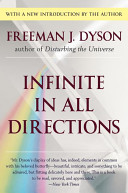Elements of Humanity's Future
The next hundred years will be a period of transition between the metal-and-silicon technology of today and the enzyme-and-nerve technology of tomorrow. The enzyme-and-nerve technology will be the result of combining the tools of genetic engineering and artificial intelligence. We cannot hope to predict the concrete forms in which a mature enzyme-and-nerve technology would express itself. When I think of the space technology of tomorrow, I think of three concrete images in particular. First, the Martian potato, a succulent plant that lives deep underground, its roots penetrating {287} layers of subterranean ice while its shoots gather carbon dioxide and sunlight on the surface under the protection of a self-generated greenhouse. Second, the comet creeper, a warm-blooded vine which spreads like a weed over the surfaces of comets and keeps itself warm with super-insulating fur as soft as sable. Third, the space butterfly which I mentioned in Chapter 9, a creature truly at home in space, acting as our agent in exploration and reconnaissance, carrying pollen and information from world to world just as terrestrial insects carry pollen from flower to flower. It is easy to dream of other inhabitants of the celestial zoo, other images of a universe coming to life. The Martian potato, the comet creeper and the space butterfly are merely symbols, intended, like the pictures in a medieval bestiary, to edify rather than to enlighten.
I will not try to describe in detail the ways which space technology might follow when we look more than a hundred years into the future. Beyond the space butterfly is a further evolution as complicated and as unpredictable as the evolution of life on Earth. Only one thing is certain. The evolution of life in the universe will be like the evolution of life on Earth, an unfolding of weird and improbable patterns, an unfolding of ever-increasing richness and diversity.
When life spreads out and diversifies in the universe, adapting itself to a spectrum of environments far wider than any one planet can encompass, the human species will one day find itself faced with the most momentous choice that we have had to make since the days when our ancestors came down from the trees in Africa and left their cousins the chimpanzees behind. We will have to choose, either to remain one species united by a common bodily shape as well as by a common history, or to let ourselves diversify as the other species of plants and animals will diversify. Shall we be forever one people, or shall we be a million intelligent species exploring diverse ways of living in a million different places across the galaxy? This is the great question which will soon be upon us. Fortunately, it is not the responsibility of this generation to answer it.
Notes:
Folksonomies: futurism diversity
Taxonomies:
/technology and computing (0.648085)
/business and industrial/advertising and marketing/marketing (0.408973)
/business and industrial/aerospace and defense/space technology (0.352955)
Keywords:
enzyme-and-nerve technology (0.996538 (positive:0.551006)), space butterfly (0.944202 (positive:0.719515)), comet creeper (0.797877 (neutral:0.000000)), Martian potato (0.779653 (negative:-0.336083)), mature enzyme-and-nerve technology (0.736434 (positive:0.434226)), common bodily shape (0.677427 (neutral:0.000000)), metal-and-silicon technology (0.563072 (positive:0.667786)), genetic engineering (0.554721 (neutral:0.000000)), artificial intelligence (0.554563 (neutral:0.000000)), space technology (0.548336 (neutral:0.000000)), succulent plant (0.547008 (positive:0.428705)), ever-increasing richness (0.544326 (positive:0.547643)), subterranean ice (0.542753 (positive:0.612097)), carbon dioxide (0.537206 (positive:0.612097)), deep underground (0.535214 (positive:0.428705)), concrete forms (0.533620 (positive:0.434226)), self-generated greenhouse (0.533146 (positive:0.612097)), warm-blooded vine (0.532557 (neutral:0.000000)), super-insulating fur (0.528800 (neutral:0.000000)), medieval bestiary (0.528192 (neutral:0.000000)), momentous choice (0.525016 (negative:-0.239912)), concrete images (0.524756 (neutral:0.000000)), improbable patterns (0.523938 (negative:-0.280718)), terrestrial insects (0.523906 (neutral:0.000000)), celestial zoo (0.521004 (positive:0.659355)), great question (0.517417 (positive:0.657826)), human species (0.507673 (negative:-0.239912)), different places (0.502789 (positive:0.424066)), common history (0.500511 (neutral:0.000000)), intelligent species (0.495198 (positive:0.424066))
Entities:
artificial intelligence:FieldTerminology (0.739975 (neutral:0.000000)), carbon dioxide:FieldTerminology (0.718735 (positive:0.612097)), Africa:Continent (0.659955 (negative:-0.239912)), hundred years:Quantity (0.659955 (neutral:0.000000)), one day:Quantity (0.659955 (neutral:0.000000))
Concepts:
Life (0.985826): dbpedia | freebase
Evolution (0.970662): dbpedia | freebase | opencyc
Universe (0.804418): dbpedia | freebase
Earth (0.793306): dbpedia | freebase
Species (0.785253): dbpedia | freebase | opencyc
Time (0.682770): dbpedia | freebase | opencyc
Biology (0.660012): dbpedia | freebase | opencyc
Plant (0.637365): dbpedia | freebase | opencyc





